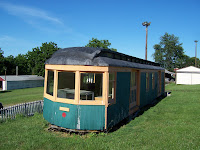It was only slightly more than a year ago than this item was posted about a streetcar that had been retrieved from inside a house and acquired by the City of Windsor in Ontario. The car in question, Sandwich Windsor & Amherstburg 351, is a very historic piece of equipment. It's the more intact (believe it or not) of only two streetcars in existence to have run on Staten Island and is one of only a few streetcars built for the U.S. War Board during WWI. It was built to a Public Service of New Jersey design by the Cincinnati Car Company, though this series may have actually been shipped as kits and assembled in New Jersey, and as such it carries some PSNJ spotting features like high-mounted side windows with arched tops, deep letterboards over the end windows, and perhaps most unusually the "monitor" roof that PSNJ used that was something of a cross between a deck roof and a Stillwell roof. The car ran on Staten Island for only eight years before it went to Ontario, where it saw a further 13 years of use until it was retired in 1939.
And that leads us to RM Auto Restoration of Chatham-Kent, Ontario. RM was contracted by the City of Windsor to rebuild car 351 as a display piece for the town and the result is turning out to be what is almost certainly the most extensive and meticulous historical restoration of a streetcar ever attempted on this continent. Mario Van Raay of RM, with whom I was put in contact by Bill Wall of Branford, has supplied a number of photos that detail the progress of this remarkable restoration up to the present time. The project is also being tracked on a City of Windsor web page which among other things includes an in-service photo of an identical car.
When car 351 arrived at RM in late 2017 it was rough, to say the least.
Much of one vestibule and nearly half of one side of the car had been completely removed when it was a house. This had to be no small operation; the car was built with steel girders extending halfway up the sides of the car beneath the windows.
The car's interior wasn't any better.
This photo shows pretty well the unusual roof profile of these cars. This type of monitor roof was virtually unique to Public Service Coordinated Transport of New Jersey, so this is an extremely rare example of a non-PSCT car with the design.
By January 2018, RM was well into the tear-down process, making sure to very carefully document the original fabric of the car at every step. This is where their experience in high-end automobile restoration has to have come in quite handy.
Not much left of the car's platform, but certainly the evidence of long-gone controllers and brake piping will be invaluable when it comes time to install replacements for those itemsThe interior seating arrangement of the car was changed during its service life, probably when it went to Windsor from Staten Island, and those changes were visible in the holes left over from seat pedestals long since removed.
The roof structure is interesting; I'm honestly not sure exactly what was here, but I'm guessing that the steel roof ribs were covered with a Masonite-like material.
By May 2018 the car was torn down completely, reducing it to its steel frame and girder sides.
Note the section of girder on the left that was chopped away during the car's use as a house.
Presto - new steel sides! Quite a bit of structural steel work was done to the car's framing.By July it was time to get the rebuilt frame painted and to start the reassembly process.
All new roof ribs ready to reinstall...
...sandwiching the original steel car lines, which have been cleaned up and painted.
And here's one of the bulkheads with quite a lot of new wood.
And that brings us to the present day. The photo at the top of this article shows car 351 as it looks now, with a virtually all-new superstructure and an incredible amount of custom-made new wooden framing.
I'm running out of superlatives to describe this project, but you can judge for yourself. Many thanks to Mario and to Bill for sending along these photos. I can't wait to see the finished product - it will really be a stunner.



































